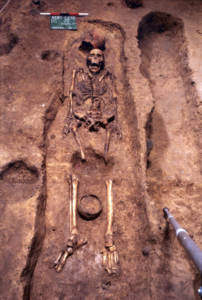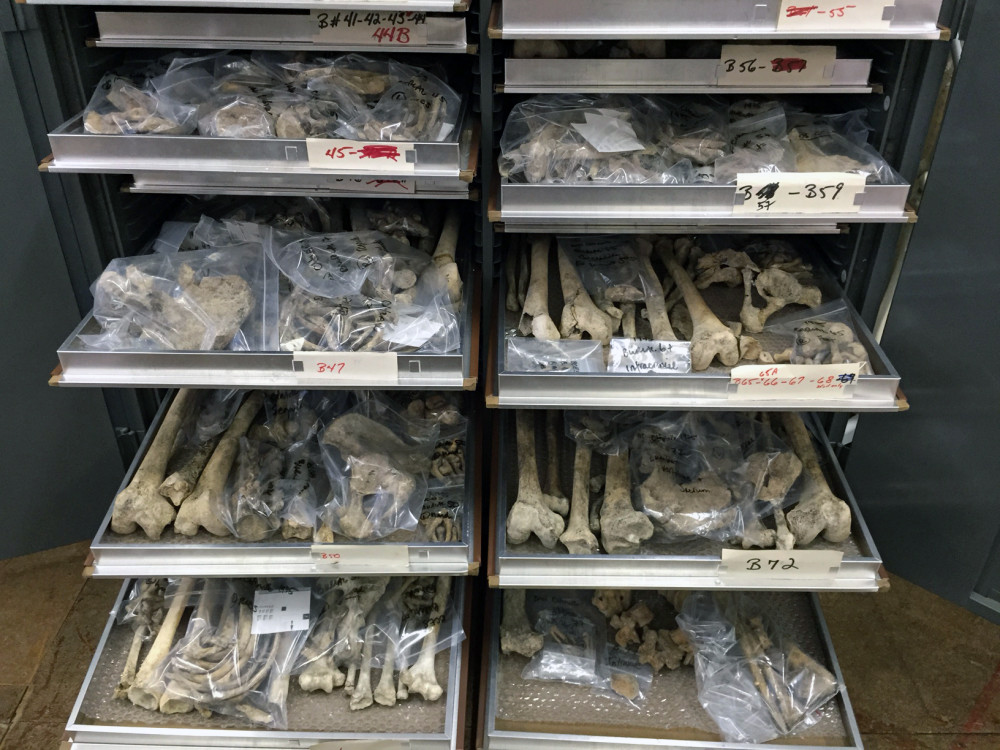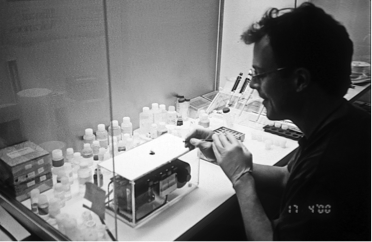Detailed analysis of Ban Chiang skeletal remains has given us a treasure-trove of information about prehistoric life in the region around Ban Chiang.
The most in-depth knowledge to date comes from Michael Pietrusewsky and Michele Toomay Douglas of the University of Hawaii, via their detailed study of 142 skeletons excavated in 1974/75 from Ban Chiang. Their 2002 monograph used modern methods of analysis to provide a wealth of evidence about health, diet, life span, social status, biological relationships, and origins of these early inhabitants of the Khorat Plateau region in northeast Thailand. About 1,500-1,700 measurements and observations per complete skeleton were recorded, as well as detailed observations of paleopathology. Complex chemical analysis yielded information about dietary patterns in the Ban Chiang population.
From these analyses comes surprising evidence of an early agricultural society that differed from those previously researched in other parts of the world. The skeletal evidence also provided new ways to think about prehistoric life in bronze and iron age cultures in mainland Southeast Asia.
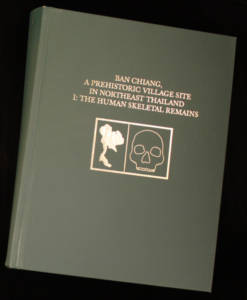
This Pietrusewsky and Douglas monograph was a turning point in understanding the diversity of human biological history in Southeast Asia. It continues to serve as a model for future research in Southeast Asian bioarchaeology.
The most unexpected findings:
- No evidence of skeletal trauma from warfare, in contrast to many other bronze and iron age societies, and little evidence of interpersonal violence.
- Unusually stable health of the Ban Chiang sample over a timespan from pre-metal to bronze/iron age, as compared to skeletal evidence from elsewhere in the world that shows dramatic health decline at the introduction of cereal agriculture.
- No evidence of a rapidly expanding population (due to higher birth rates) that was common in other early agricultural societies.
- No evidence for differential access to subsistence resources, i.e. none of the status-associated differences in skeletal health often found in hierarchical societies.
- Unexpected differences in health, demography, and possibly genetics in (inland) Ban Chiang, vs. coastal Thailand (e.g. Khok Phanom Di) of the same time period.
- Indications of long-term regional continuity of populations in mainland Southeast Asia (and no evidence that Ban Chiang populations migrated from a distant region like present-day China).
Other key findings:
- Life expectancy: Although the age of the Ban Chiang skeletons ranged from fetuses to over 50 years of age, life expectancy at birth averaged 29.5 years. If the individual survived to age 15, he or she could expect to live to 38 years on average.
- Average height was 166 cm (5 feet, 5 inches) for males and 154 cm (5 feet, 1 inch) for females.
- Life was physically demanding. There were significant levels of skeletal pathology associated with activity and workload (degenerative joint disease, enthesiopathies and related conditions). Male skeletons had more activity-related pathology than females—suggesting there was some division of labor between the sexes.
- Possible evidence for a “matrilocal system” based on analysis of stable isotopes in the teeth of Ban Chiang skeletons. In a matrilocal system, men from other areas relocate to live in their wives’ village.
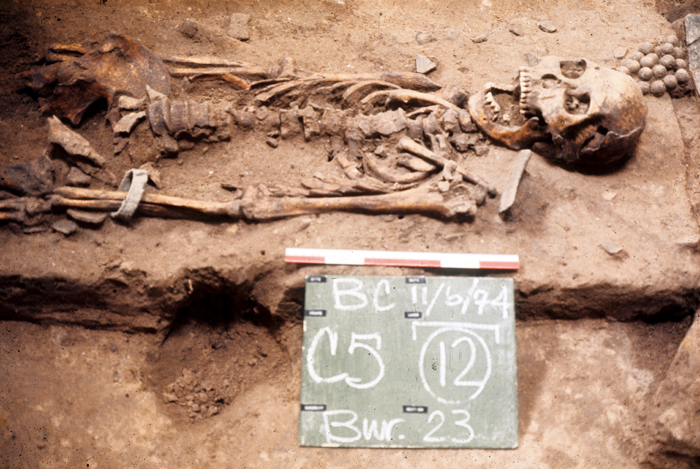
This skeleton, BC Burial 23, affectionately dubbed “Vulcan” by archaeologists at Ban Chiang, was a 45-50 year old male.
In-depth analyses of skeletal remains also yielded “biographies” for individuals, including information about age, sex, health, diet, lifeways, and hints of social status. Read about“Vulcan: skilled village craftsman of Ban Chiang, Thailand”.

Vulcan, BC Burial 23. Showing a large alveolar defect (abscess) of Vulcan’s left mandibular first molar socket. Probably a result of exposure of the tooth pulp due to excessive wear in this tooth.
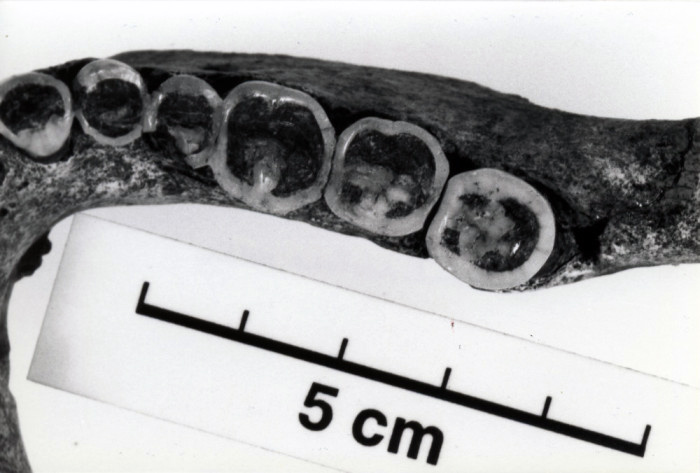
An example of dental wear in another Ban Chiang skeleton (BCES Burial 47), a male roughly the same age as Vulcan. The dentin is exposed in all teeth and the crowns are evenly worn. If not worn, the dentin would have been covered by enamel.
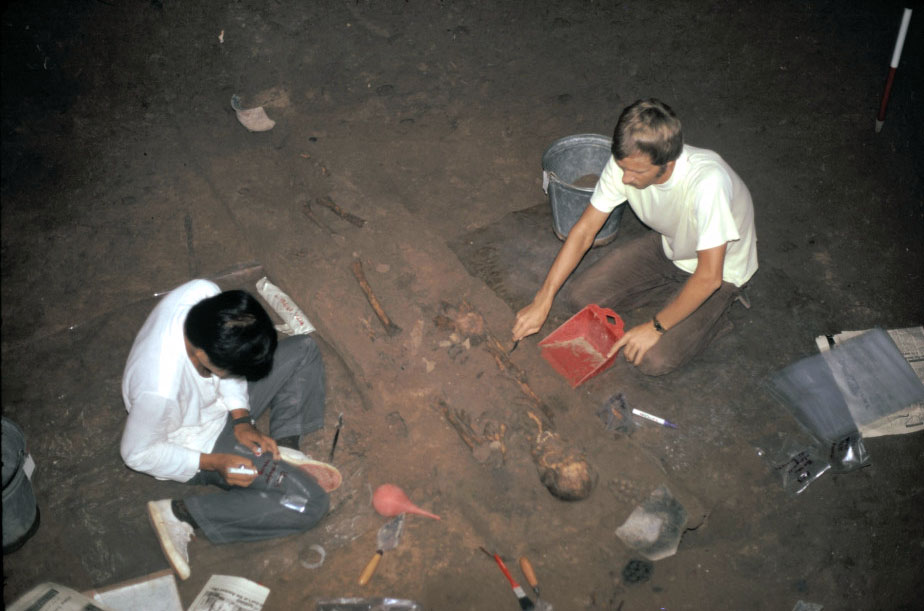
Ban Chiang 1974 excavation of Vulcan (BC Burial 23) by Pisit Charoenwongsa and Michael Pietrusewsky.
See Alex Bentley’s results: “Matrilocality during the prehistoric transition to agriculture in Thailand?”
Read more:
Halcrow, S. E., N.J. Harris, N. Tayles, R. Ikehara-Quebral, and M. Pietrusewsky
2013 From the mouths of babes: dental caries in infants and children and the intensification of agriculture in mainland Southeast Asia. American Journal of Physical Anthropology 150(3):409-420.
Pietrusewsky, M. and M.T. Douglas
2012 Vulcan: skilled village craftsman of Ban Chiang, Thailand. In: Stodder, A.L.W., A.M. Palkovich, editors. The Bioarchaeology of Individuals. Gainesville: University Press of Florida, pp. 177-192.
Pietrusewsky, M. and M.T. Douglas
2007 Biological consequences of sedentism and agricultural intensification in Northeast Thailand. In: Cohen, M.N., G. Crane-Kramer, editors. Ancient Health: Skeletal Indicators of Agricultural and Economic Intensification (Bioarchaeological Interpretations of the Human Past: Local, Regional, and Global Perspectives). Gainesville: University Press of Florida, pp. 300-319.
Pietrusewsky, M.
2006 A multivariate craniometric study of the prehistoric and modern inhabitants of Southeast Asia, East Asia, and surrounding regions: a human kaleidoscope? In: Oxenham M., N. Tayles, editors. Bioarchaeology of Southeast Asia. Cambridge University Press, pp. 59-90.
Bentley, R. A., M. Pietrusewsky, M. T. Douglas and T. C. Atkinson
2005 Matrilocality during the prehistoric transition to agriculture in Thailand?Antiquity 79(306):865-881.
Pietrusewsky, M. and M.T. Douglas
2002 Ban Chiang, a Prehistoric Village Site in Northeast Thailand I: the Human Skeletal Remains. Thai Archaeology Monograph Series I. University of Pennsylvania Museum of Archaeology and Anthropology, Philadelphia. Buy the monograph.
Pietrusewsky, M. and M.T. Douglas
2002 Intensification of agriculture at Ban Chiang: Is there evidence from the skeletons? Asian Perspectives 40(2):157-178.
Pietrusewsky, M.
1997 The people of Ban Chiang: an early bronze site in northeast Thailand. Bulletin of the Indo-Pacific Prehistory Association 16:119-147.
Pietrusewsky, M.
1994 Report on new fieldwork on Bronze-Age skeletons from Ban Chiang, Northeast Thailand. In Jablonski, N.G., editor. The East Asian Tertiary/Quaternary Newsletter No. 18/1994: 81-82.
Pietrusewsky, M.
1984 Pioneers on the Khorat Plateau: the prehistoric inhabitants of Ban Chiang. Journal of the Hong Kong Archaeological Society 10:90-106.
Pietrusewsky, M.
1982 The ancient inhabitants of Ban Chiang: the evidence from the human skeletal and dental remains. Expedition 24(4):13-16.
Pietrusewsky, M.
1981 Cranial variation in early metal age Thailand and Southeast Asia studied by multivariate procedures. Homo 32:1-26.
Pietrusewsky, M.
1978 A study of early metal age crania from Ban Chiang, northeastern Thailand. Journal of Human Evolution 7:383-392.
Pietrusewsky, M.
1974 The paleodemography of a prehistoric Thai population: Non Nok Tha. Asian Perspectives 17 (2):125-140.
Pietrusewsky, M.
1974 Neolithic populations of Southeast Asia studied by multivariate craniometric analysis. Homo 25(4):207-230.

